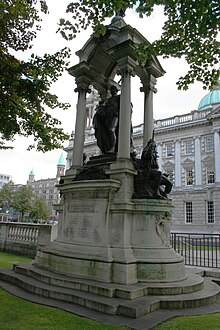Frederick Hamilton-Temple-Blackwood, 1st Marquess of Dufferin and Ava
Frederick Hamilton-Temple-Blackwood, 1st Marquess of Dufferin and Ava, KP, GCB, GCSI, GCMG, GCIE, PC (21 June 1826 – 12 February 1902), was a British public servant and prominent member of Victorian society.
[1] In his youth he was a popular figure in the court of Queen Victoria, and became well known to the public after publishing a best-selling account of his travels in the North Atlantic.
His long career in public service began as a commissioner to Syria in 1860, where his skilful diplomacy maintained British interests while preventing France from instituting a client state in Lebanon.
After his success in Syria, Dufferin served in the Government of the United Kingdom as the Chancellor of the Duchy of Lancaster[2] and Under-Secretary of State for War.
In 1872 he became Governor General of Canada, bolstering imperial ties in the early years of the Dominion, and in 1884 he reached the pinnacle of his official career as Viceroy of India.
Following his retirement from the diplomatic service in 1896, his final years were marred by personal tragedy and a misguided attempt to secure his family's financial position.
The Blackwood family became prominent landowners in Ulster over the following two hundred years, and were created baronets in 1763, entering the Peerage of Ireland in 1800 as Baron Dufferin.
Returning to Reykjavík, Foam was towed north by Prince Napoleon, who was on an expedition to the region in the steamer La Reine Hortense.
[7] Working with French, Russian, Prussian and Turkish representatives on the commission, Dufferin proved remarkably successful in achieving the objectives of British policy in the area.
[8] Lord Dufferin took the name Hamilton by royal licence on 9 September 1862, shortly before his marriage to Hariot Georgina Rowan-Hamilton on 23 October 1862.
[8] They had seven surviving children; the two youngest, a son and a daughter, were born in Canada: Shortly after his marriage, he was deeply upset when his mother married his friend George Hay, Earl of Gifford, a man some 17 years her junior.
Despite his disapproval of his mother's second marriage, Lord Dufferin was devastated by her death in 1867, and built Helen's Tower, a memorial to her, on the estate at Clandeboye.
At a time when a weak or uncharismatic Governor General might have loosened the ties to Empire, Dufferin felt that involving himself with the people of Canada would strengthen constitutional links to Britain.
He established an Office of the Governor General in a wing of the Parliament buildings, and Lady Dufferin attended many debates and reported back to him.
He also attracted ordinary Canadians to the Hall grounds by constructing an ice skating rink, to which he contributed CA$1,624.95 of his own money, which was later reimbursed by the government.
[13] Lady Dufferin also maintained a high profile during her husband's term as Governor General, accompanying him on tours and frequently appearing in public.
[10] The popularity and influence of the Dufferins in Canada is reflected by the large number of Canadian schools, streets and public buildings named after them.
His posting there saw Britain invade and occupy Egypt, then technically part of the Ottoman Empire, under the pretext of "restoring law and order" following anti-foreign riots in Alexandria which had left nearly 50 foreigners dead, and Dufferin was heavily involved in the events surrounding the occupation.
Britain and Russia had for decades been engaged in a virtual cold war in Central Asia and India, known as the Great Game, and the Panjdeh incident threatened to precipitate a full-blown conflict.
The report highlighted the plight of the poor in Bengal, and was used by nationalists to counter the Anglo-Indian claim that British rule had been beneficial to the poorest members of Indian society.
Following publication of the report, Dufferin recommended the establishment of provincial and central councils with Indian membership, a key demand of Congress at that time.
Her extensive travel writings and photographs, in addition to her medical work, challenge some traditional assumptions about the role of women in colonial life.
After he retired from the diplomatic service in 1896, he received several offers from financial speculators hoping to use his high reputation to attract investors to their companies.
Late one night in 1849, while staying in a house in Tullamore, County Offaly, Ireland, he heard a hearse draw up, and looked down and saw a man walking across the lawn carrying a coffin on his back.
Some years later Dufferin – by this point, the British ambassador to France – recognised the lift operator at the Grand Hotel in Paris as the man he had seen in the garden in Ireland.
He refused to get into the lift and a moment later it crashed, killing the occupants including the mysterious man, who had only begun work at the hotel that morning.
[21][22] French journalist Paul Heuzé demonstrated that up to the time of his research in 1922, only one person had been killed in a Grand Hotel lift accident, in 1878, years before Dufferin was in Paris.
[23] A more recent investigation by BBC researcher Melvin Harris demonstrated that the story was an urban legend which Dufferin improved upon by telling as a personal anecdote.
It was again retold by Bennett Cerf in his collection Famous Ghost Stories in 1944, which in turn was adapted in the episode Twenty Two of The Twilight Zone.








